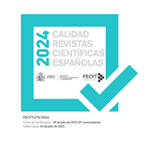Esperanza y equilibrio en el mundo distópico de Los Juegos del Hambre
Resumen
Esta propuesta proporciona evidencia de la utilidad de combinar categorías analíticas de la Lingüística Cognitiva y del Análisis Crítico del Discurso para el análisis de caracterizaciones literarias complejas. Esto se hace a través de un estudio detallado de los llamados “tributos”, los niños seleccionados de forma aleatoria que tienen que luchar hasta la muerte en un programa televisado nacionalmente, en Los Juegos del Hambre. Este estudio demuestra la efectividad de tales herramientas provenientes de ambos marcos teóricos para proporcionar un panorama riguroso desde el punto de vista analítico del mundo distópico representado en la novela, que revela la inclusión de un elemento paradójico de esperanza. El tipo de deshumanización que caracteriza la sociedad distópica de Panem se refleja a través de un conjunto internamente consistente de metáforas ontológicas que proyectan aspectos negativos de formas de existencia inferiores sobre seres humanos. Esta selección de metáforas fomenta una perspectiva sesgada de los pobres habitantes de Panem a la vez que legitima las desigualdades sociales que el pudiente Capitol se aplica a fondo por perpetuar. Sin embargo, Katniss sufre una metamorfosis a través del descubrimiento de su propia identidad, que apunta hacia un empoderamiento femenino emergente. Esta transformación, junto a su identificación con el Mockingjay, un ser sobrenatural que da voz a sus creencias y emociones, contribuye a perturbar el statu quo impuesto por los todopoderosos Vigilantes de los Juegos y a transmitir un mensaje de optimismo.
Descargas
Descarga artículo
Licencia
La revista Círculo de Lingüística Aplicada a la Comunicación, para fomentar el intercambio global del conocimiento, facilita el acceso sin restricciones a sus contenidos desde el momento de su publicación en la presente edición electrónica, y por eso es una revista de acceso abierto. Los originales publicados en esta revista son propiedad de la Universidad Complutense de Madrid y es obligatorio citar su procedencia en cualquier reproducción total o parcial. Todos los contenidos se distribuyen bajo una licencia de uso y distribución Creative Commons Reconocimiento 4.0 (CC BY 4.0). Esta circunstancia ha de hacerse constar expresamente de esta forma cuando sea necesario. Puede consultar la versión informativa y el texto legal de la licencia.











